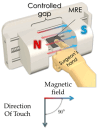Sensors and Sensing Devices Utilizing Electrorheological Fluids and Magnetorheological Materials-A Review
- PMID: 38732948
- PMCID: PMC11086258
- DOI: 10.3390/s24092842
Sensors and Sensing Devices Utilizing Electrorheological Fluids and Magnetorheological Materials-A Review
Abstract
This paper comprehensively reviews sensors and sensing devices developed or/and proposed so far utilizing two smart materials: electrorheological fluids (ERFs) and magnetorheological materials (MRMs) whose rheological characteristics such as stiffness and damping can be controlled by external stimuli; an electrical voltage for ERFs and a magnetic field for MRMs, respectively. In this review article, the MRMs are classified into magnetorheological fluids (MRF), magnetorheological elastomers (MRE) and magnetorheological plastomers (MRP). To easily understand the history of sensing research using these two smart materials, the order of this review article is organized in a chronological manner of ERF sensors, MRF sensors, MRE sensors and MRP sensors. Among many sensors fabricated from each smart material, one or two sensors or sensing devices are adopted to discuss the sensing configuration, working principle and specifications such as accuracy and sensitivity. Some sensors adopted in this article include force sensors, tactile devices, strain sensors, wearable bending sensors, magnetometers, display devices and flux measurement sensors. After briefly describing what has been reviewed in a conclusion, several challenging future works, which should be undertaken for the practical applications of sensors or/and sensing devices, are discussed in terms of response time and new technologies integrating with artificial intelligence neural networks in which several parameters affecting the sensor signals can be precisely and optimally tuned. It is sure that this review article is very helpful to potential readers who are interested in creative sensors using not only the proposed smart materials but also different types of smart materials such as shape memory alloys and active polymers.
Keywords: electrorheological fluid; flux measurement sensor; force sensor; magnetorheological materials; sensors; strain sensor; tactile sensor.
Conflict of interest statement
The authors declare no conflicts of interest. The authors also declare that they have no known competing financial interests or personal relationships that could have appeared to influence the work reported in this paper.
Figures
















References
-
- Bonnecaze R.T., Brady J.F. Dynamic Simulation of an Electrorheological Fluid. J. Chem. Phys. 1992;96:2183–2202. doi: 10.1063/1.462070. - DOI
-
- Tian H. Electrorheological Fluids. Adv. Mater. 2001;13:1847–1857.
-
- Schneider S., Eibl S. Review of the Electrorheological (Er) Effect of Polyurethane-Based Er Fluids. Appl. Rheol. 2008;18:23956-1–23956-8. doi: 10.1515/arh-2008-0007. - DOI
Publication types
LinkOut - more resources
Full Text Sources
Miscellaneous

